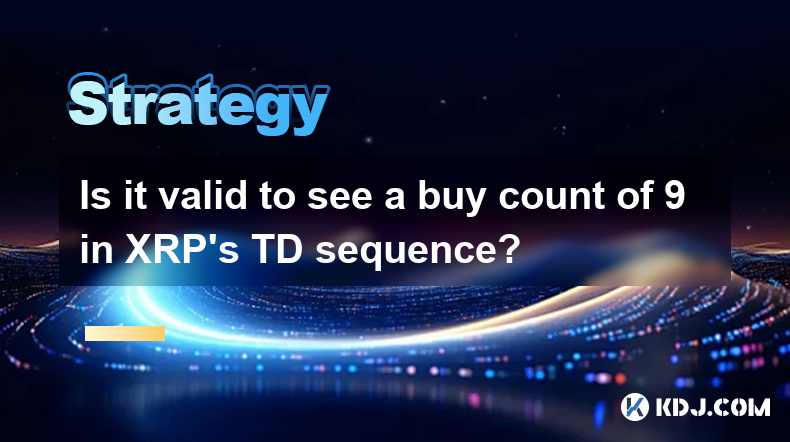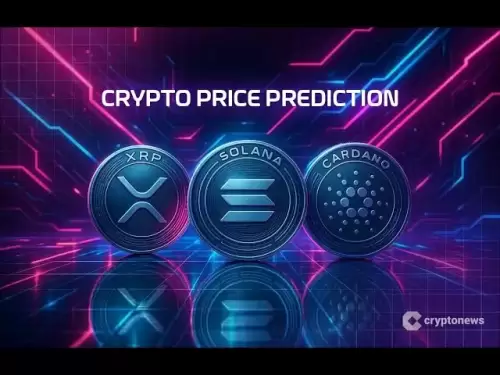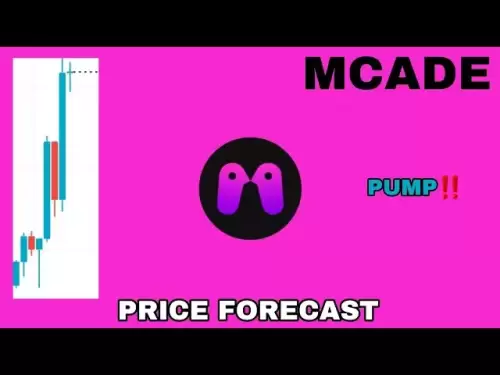-
 Bitcoin
Bitcoin $118,209.3536
1.16% -
 Ethereum
Ethereum $3,151.7546
5.98% -
 XRP
XRP $2.9277
2.35% -
 Tether USDt
Tether USDt $1.0000
0.00% -
 BNB
BNB $689.7099
1.26% -
 Solana
Solana $163.4270
1.91% -
 USDC
USDC $1.0000
0.02% -
 Dogecoin
Dogecoin $0.1983
3.74% -
 TRON
TRON $0.3008
0.51% -
 Cardano
Cardano $0.7435
2.86% -
 Hyperliquid
Hyperliquid $47.6547
-0.48% -
 Stellar
Stellar $0.4625
2.79% -
 Sui
Sui $3.9921
2.71% -
 Chainlink
Chainlink $16.0608
4.23% -
 Hedera
Hedera $0.2348
1.56% -
 Bitcoin Cash
Bitcoin Cash $496.6985
1.25% -
 Avalanche
Avalanche $21.9038
5.41% -
 UNUS SED LEO
UNUS SED LEO $8.8356
-1.88% -
 Shiba Inu
Shiba Inu $0.0...01364
5.31% -
 Toncoin
Toncoin $3.1102
4.35% -
 Litecoin
Litecoin $95.9756
3.59% -
 Polkadot
Polkadot $4.0925
5.78% -
 Monero
Monero $333.7622
-1.44% -
 Uniswap
Uniswap $9.1968
2.25% -
 Bitget Token
Bitget Token $4.6378
6.23% -
 Pepe
Pepe $0.0...01282
6.77% -
 Dai
Dai $1.0002
0.03% -
 Ethena USDe
Ethena USDe $1.0005
0.00% -
 Aave
Aave $329.9143
4.49% -
 Bittensor
Bittensor $441.4995
6.89%
Is it valid to see a buy count of 9 in XRP's TD sequence?
A buy count of 9 in XRP's TD sequence is valid if price bars meet the TD Setup criteria, but traders should confirm with volume and other indicators for reliability.
Apr 24, 2025 at 02:56 pm

The Tom Demark (TD) Sequential indicator is a popular tool among cryptocurrency traders, particularly when analyzing assets like XRP. It is designed to predict potential price reversals by identifying overbought or oversold conditions in the market. One common question among traders is whether a buy count of 9 in XRP's TD sequence is valid. To address this, we need to delve into the mechanics of the TD Sequential indicator and its application to XRP.
Understanding the TD Sequential Indicator
The TD Sequential indicator was developed by Tom Demark and is used to identify potential price exhaustion points. It consists of two main components: the TD Setup and the TD Countdown. The TD Setup counts the number of consecutive price bars that meet specific criteria, leading to a potential reversal signal. The TD Countdown then refines this signal by counting additional bars to confirm the reversal.
The TD Setup and Buy Count of 9
The TD Setup is crucial for understanding the validity of a buy count of 9 in XRP's TD sequence. For a buy setup, the indicator looks for a sequence where each price bar's low is lower than the low four bars earlier. The setup completes when there are nine consecutive price bars that satisfy this condition. This completion signals a potential price reversal from a downtrend to an uptrend, hence the term "buy setup."
Validity of a Buy Count of 9 in XRP
A buy count of 9 in XRP's TD sequence is indeed valid, provided that the price bars meet the criteria set by the TD Setup. However, it is essential to consider the context in which this count occurs. The effectiveness of the TD Sequential indicator can vary depending on the market conditions and the asset's volatility. For XRP, traders often look at additional factors such as volume, market sentiment, and other technical indicators to confirm the signal.
Applying the TD Sequential Indicator to XRP
To apply the TD Sequential indicator to XRP, traders typically follow these steps:
- Select a reliable charting platform that supports the TD Sequential indicator, such as TradingView or MetaTrader.
- Apply the TD Sequential indicator to the XRP price chart, ensuring it is set to the desired timeframe (e.g., daily, hourly).
- Monitor the TD Setup for a buy count of 9, where each price bar's low is lower than the low four bars earlier.
- Confirm the signal with additional analysis, such as volume spikes or other technical indicators like the Relative Strength Index (RSI) or Moving Averages.
Interpreting the TD Countdown
After the TD Setup completes with a buy count of 9, the TD Countdown begins. This phase counts additional price bars to confirm the potential reversal. For a buy signal, the countdown looks for a sequence where each price bar's high is higher than the high two bars earlier. The countdown completes when there are 13 consecutive price bars that satisfy this condition, further validating the buy signal.
Practical Example of a Buy Count of 9 in XRP
Let's consider a practical example of a buy count of 9 in XRP's TD sequence. Suppose the daily chart of XRP shows a downtrend, and the TD Setup begins to count consecutive price bars where each bar's low is lower than the low four bars earlier. After nine such bars, the TD Setup completes, signaling a potential reversal. Traders would then monitor the TD Countdown to confirm the buy signal, looking for 13 consecutive bars where each bar's high is higher than the high two bars earlier.
Factors Affecting the Validity of the Signal
Several factors can affect the validity of a buy count of 9 in XRP's TD sequence:
- Market Volatility: High volatility can lead to false signals, so traders should be cautious during periods of significant price fluctuations.
- Volume: A buy signal is more reliable if accompanied by increasing trading volume, indicating strong market participation.
- Timeframe: The effectiveness of the TD Sequential indicator can vary across different timeframes. Shorter timeframes may produce more signals but with lower reliability, while longer timeframes may offer more reliable signals but with fewer opportunities.
Using Additional Technical Indicators
To enhance the reliability of a buy count of 9 in XRP's TD sequence, traders often use additional technical indicators:
- Relative Strength Index (RSI): An RSI reading below 30 can confirm an oversold condition, supporting the buy signal from the TD Sequential indicator.
- Moving Averages: A bullish crossover of shorter-term moving averages over longer-term moving averages can reinforce the buy signal.
- MACD (Moving Average Convergence Divergence): A bullish MACD crossover can provide further confirmation of a potential price reversal.
Real-World Application and Case Studies
To illustrate the application of a buy count of 9 in XRP's TD sequence, let's examine a few case studies:
Case Study 1: In early 2023, XRP experienced a prolonged downtrend. The TD Setup on the daily chart completed a buy count of 9, signaling a potential reversal. Traders who entered long positions based on this signal and confirmed it with increasing volume and a bullish RSI reading saw significant gains as XRP rebounded.
Case Study 2: In mid-2022, a buy count of 9 appeared on the hourly chart of XRP. However, the signal was not confirmed by the TD Countdown, and the price continued to decline. This example highlights the importance of waiting for the TD Countdown to complete before acting on the signal.
Case Study 3: During a volatile period in late 2021, a buy count of 9 on the 4-hour chart of XRP was accompanied by a strong bullish divergence in the RSI. Traders who used this additional confirmation saw a successful trade as XRP reversed and moved higher.
Frequently Asked Questions
Q: Can the TD Sequential indicator be used on other cryptocurrencies besides XRP?
A: Yes, the TD Sequential indicator can be applied to any cryptocurrency. Its effectiveness may vary depending on the asset's volatility and market conditions, but the principles remain the same.
Q: How often should I check the TD Sequential indicator for XRP?
A: The frequency of checking the TD Sequential indicator depends on your trading strategy and timeframe. For long-term traders, checking daily or weekly charts may be sufficient, while short-term traders might monitor hourly or 4-hour charts.
Q: Is it necessary to wait for the TD Countdown to complete before acting on a buy signal from the TD Setup?
A: While it is not strictly necessary, waiting for the TD Countdown to complete can increase the reliability of the signal. The TD Countdown provides additional confirmation of the potential reversal, reducing the risk of false signals.
Q: Can the TD Sequential indicator be used in conjunction with other trading strategies?
A: Yes, the TD Sequential indicator can be effectively combined with other trading strategies and technical indicators. Many traders use it alongside tools like RSI, Moving Averages, and MACD to enhance their analysis and decision-making process.
Disclaimer:info@kdj.com
The information provided is not trading advice. kdj.com does not assume any responsibility for any investments made based on the information provided in this article. Cryptocurrencies are highly volatile and it is highly recommended that you invest with caution after thorough research!
If you believe that the content used on this website infringes your copyright, please contact us immediately (info@kdj.com) and we will delete it promptly.
- Bitcoin, Crypto, and Rate Cut Hopes: A Bullish Brew for the Summer?
- 2025-07-17 00:30:12
- Swedish Refine Group's $1M Bitcoin Treasury Strategy: A Growing Trend
- 2025-07-17 00:30:13
- Avalanche Onchain Insights: Token Relations Unveils Comprehensive Dashboards
- 2025-07-16 22:50:13
- Standard Chartered's Crypto Leap: Regulated Trading and Stablecoin Focus
- 2025-07-16 23:30:13
- Rare Coin Alert: Darwin, Ipswich, and Hidden Treasures!
- 2025-07-16 23:30:13
- Shiba Inu vs. Remittix: Can Remittix Deliver Gains Faster?
- 2025-07-16 23:35:13
Related knowledge

How to avoid common crypto investment mistakes?
Jul 13,2025 at 01:35am
Understanding the Risks of Crypto InvestmentInvesting in cryptocurrency can be highly rewarding, but it also comes with significant risks. One of the ...

What is a long-short crypto strategy?
Jul 15,2025 at 10:56am
Understanding the Basics of a Long-Short Crypto StrategyA long-short crypto strategy is an investment approach where traders simultaneously take long ...

What is a long-short crypto strategy?
Jul 11,2025 at 01:28pm
Understanding the Basics of Long-Short Crypto StrategyA long-short crypto strategy is an investment approach where traders take both long and short po...

How to use the RSI indicator for crypto?
Jul 12,2025 at 03:56pm
Understanding the RSI Indicator in Cryptocurrency TradingThe Relative Strength Index (RSI) is a momentum oscillator used to measure the speed and chan...

Is copy trading a good strategy for crypto beginners?
Jul 12,2025 at 08:28am
Understanding Copy Trading in the Cryptocurrency MarketCopy trading is a strategy where novice traders replicate the trades of experienced investors a...

How to build a crypto portfolio with $1000?
Jul 13,2025 at 08:14pm
Understanding the Basics of Cryptocurrency InvestmentBuilding a crypto portfolio with $1000 starts with understanding the fundamentals of cryptocurren...

How to avoid common crypto investment mistakes?
Jul 13,2025 at 01:35am
Understanding the Risks of Crypto InvestmentInvesting in cryptocurrency can be highly rewarding, but it also comes with significant risks. One of the ...

What is a long-short crypto strategy?
Jul 15,2025 at 10:56am
Understanding the Basics of a Long-Short Crypto StrategyA long-short crypto strategy is an investment approach where traders simultaneously take long ...

What is a long-short crypto strategy?
Jul 11,2025 at 01:28pm
Understanding the Basics of Long-Short Crypto StrategyA long-short crypto strategy is an investment approach where traders take both long and short po...

How to use the RSI indicator for crypto?
Jul 12,2025 at 03:56pm
Understanding the RSI Indicator in Cryptocurrency TradingThe Relative Strength Index (RSI) is a momentum oscillator used to measure the speed and chan...

Is copy trading a good strategy for crypto beginners?
Jul 12,2025 at 08:28am
Understanding Copy Trading in the Cryptocurrency MarketCopy trading is a strategy where novice traders replicate the trades of experienced investors a...

How to build a crypto portfolio with $1000?
Jul 13,2025 at 08:14pm
Understanding the Basics of Cryptocurrency InvestmentBuilding a crypto portfolio with $1000 starts with understanding the fundamentals of cryptocurren...
See all articles

























































































